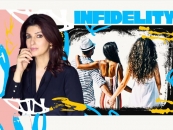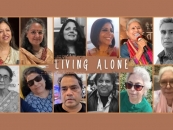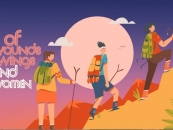Move over Amish. With the innovatively titled ‘Sati Series’, Koral Dasgupta is providing a much-welcome lens through which to look at our mythological texts. The author spoke to Shantanu Ray Chaudhuri.
‘I want to create a magnum opus where Sanjay Leela Bhansali meets Mira Nair’. Koral Dasgupta is the author of six books. Her books on the pancha kanyas, a five-book series of which two, Ahalya and Kunti, are out, are generating conversations around the genre. Forthcoming in the series are Draupadi, Mandodari and Tara. Koral wears multiple hats. She is a painter. Koral founded www.tellmeyourstory.biz - a digital-media popularising academic research and social narratives through stories. She also conducts writing programs and critical thinking workshops for educational and corporate floors.
Winter Collections, Rasia, Summer Holidays, even a book on connecting with consumers the SRK way, Power of a Common Man - from these you seem to have taken a quantum leap into antiquity with the Sati series. How did the transformation come about?
Both Fall Winter Collections and Rasia had strong elements of mythology as a part of the core story. But this series is more direct. I have always been fascinated with the Indian epics and their characters. I have asked myself all kinds of questions, discussing various possibilities in my mind. I guess when you spend too much time on something, they get friendlier. Maybe that’s what happened with me. I had never planned to be a mythology writer though. The story of Ahalya was a spark of an idea. It pulled me into the rest. I had written a one-sentence pitch to the publisher after writing Ahalya. I was clueless what the rest of the books in the series would be like. Things just worked out.
What was the one-sentence pitch?
Five women with multiple partners were called eternal virgins (meaning untouched) and Maha Sati (meaning pure) by ancient Indian texts, which proves that the entire taboo on women's bodies is a misinformation fed by patriarchal society and not an endorsement from the holy books.
The series of books is titled ‘The Sati Series’. Given the connotation the word ‘Sati’ has - The Merriam Webster Dictionary defines it as ‘the act or custom of a Hindu widow burning herself to death or being burned to death on the funeral pyre of her husband’ – do you see that as problematic?
That meaning refers to a historical practice. For centuries women have been rigidly governed by patriarchy. The practice of Sati was a dirty and violent manifestation of such governance under the pretext of religion. The concept of ‘purity’ in Hinduism has nothing to do with the body. Hindu philosophy has always celebrated the broader aspect of being – the body is only a temporary home for the soul till it is on earth, bound by earthly protocols. Beyond that, the soul belongs to the universe and experiences complete freedom. I could have named the series Pancha Kanya – who are called Maha Satis. They were ‘pure’ because of their clarity of vision and determination, which were ‘untouched’ by the events that tried to distract them. The title ‘Sati Series’ is sarcastic about that phase of our past, which misused a noble concept to inflict cruelty upon women and establish purity.
7.jpg)
What do you mean by ‘noble concept’ when you mention Sati?
‘Pure’ and ‘untouched’… both in inverted commas, as I previously said: They were ‘pure’ because of their clarity of vision and determination, which were ‘untouched’ by the events that tried to distract them. It is about their courage and determination to follow their path and not be ‘touched’ by the distractions caused by others. That is what our ancient texts say about Sati. And that is how society has convoluted the idea of touch in the context of women, doing cruel things so they feel afraid and remain submissive.
What made you think of the Pancha Kanyas as a continuing theme to address? What is it about Ahalya, Kunti, Draupadi, Mandodari, Tara that attracted you to tell these stories? There are variations where Sita replaces Kunti. Why have you chosen Kunti over Sita?
I heard Ahalya’s story when I was a child. I learnt that if a woman is wronged, she will be punished whether or not she is at fault. I heard Sita’s story and understood that women’s foolishness caused great wars. Draupadi’s story told me that women are dependent on men in winning their battles. I grew up thinking that my religion and culture prefers timid, obedient and sacrificing women. Much later I realized that Hindu philosophical literature is immensely progressive and tremendously empowering.
The stories were told (and shown) to me in a way that restricts my dreams and freedom as a human being. It was this realization that drew me towards this series. Kunti was named as one of the Pancha Kanyas in the ancient texts. Later, in some retellings, she was replaced by Sita. Also, Sita is a part of another construct called Pancha Sati, which was coined by the later versions and popularized in recognition of the most obedient wives. In my series, Sita will leave a very strong impression both in Mandodari’s story and in Tara’s. So Kunti was the obvious choice.
One of the fascinating aspects of the Pancha Kanyas is the ‘chastity’ that is eulogized in Sanskrit hymns: ahalyā draupadī kuṃtī tārā mandodarī tathā। pañcakanyāḥ smarennityaṃ mahāpātakanāśinīm॥ Ahalya, Draupadi, Kunti, Tara and Mandodari/If the panchakanya are worshipped regularly, great sins will be dispelled. Yet, each of these women engaged in relationships that would be frowned upon even today. How did you negotiate these narratives to create your own?
Writing the Sati series has been intellectually exhausting but spiritually rewarding. You see, the multiple relationships of these women could be as common as the multiple marriages of the men - Dashratha, Arjun, Shantanu, there are so many. Men’s marriages are perceived as purposeful, women’s relationships are scandalous. I am relooking at the stories without the mind blocks. During this journey, I realized that the shloka you mentioned doesn’t invite one to chant the names of the five women every day. It rather talks about spending time on these women and understanding their decisions. A lot of doubts vanish, one gets clarity on what is not worth chasing, how to focus on personal goals and how to disconnect from the external chaos that tries to entrap people into cages without their knowledge. The gender politics of many eras stand exposed, which have created an unfair world not only for women but also men. I understood a lot about women’s leadership in Indian culture. These aspects reflect in my work.
When I am thinking-planning-writing, it feels like meditation. I perceive a freedom in building the narratives of the mythical women, having grown up in a society where women’s strengths have been portrayed as their weaknesses. This makes me feel richer. It is so unfortunate that ‘Sati’ is remembered as a religio-political practice when it was supposed to be a spiritual designation.
8.jpg)
Give us an insight into the research that went into these? What were the sources? An insight into the writing process? How much time does each narrative take to write down?
I have read many versions of the epics and the Gita during various phases of my life. Comics to elaborate translations, I have swum through various presentations. I have also read the works of many great authors who have worked on the genre. Those are my homeworks.
Now, I am not undertaking any special research to get here. My model is simple. I keep the original storyline unaltered and present an interpretation that is far more liberated than the patriarchal narratives we have grown up with. In between when I need certain fact checking, I ask my friends and seniors who are working on Indian mythology in different capacities.
I have never been a planned writer. So I can never do research before and get to work only when I have everything in hand. I don’t know how the writing will flow till I am on the desk. I need information impromptu and the people I have fallen back on have been truly kind. Writing the first draft takes 2-3 months. I complete the draft of the manuscript a long time before submission so that I can revise and modify umpteen times. I don’t submit easily.
One of the most critical dimensions of this work is to be careful about pulling myself out of the mythical characters. I remember writing in Kunti that she closed her eyes upon seeing something brutal. While editing I realized, that is me, not Kunti – having been born and bred in royalty, she must have experienced bigger brutality than the one mentioned. The other interesting aspect is the contemporary contextualization of ancient stories. Mythology repeats itself, I get to see them. I write from those real-life sensibilities.
The lazy way of looking at these is to see them as ‘feminist’ readings - what’s your take on that? If you were to list one aspect of each of the kanyas that proved to be (i) inspirational and (ii) problematic that could have made you want to explore these?
Why only feminist? Take any divisive motive for that matter. Caste, religion, social status, gender and suchlike - all of which are power dynamics to establish supremacy of one group over another. I am not trying to do any feminist job, or any other activism for that matter. I don’t have any agenda. Honestly, I am not even looking at them as inspirational or problematic. They have had an interesting journey, and so did their antagonists.
However, when you flip the stories to view them from a woman’s perspective, they become more inclusive. I am not forcing it, that’s how it is. We didn’t notice because we were conditioned to look at them differently. When you consider these aspects, you realize that the patriarchal narratives have not only violated women but men too. Let me share an example. Arjun was cursed by Urvashi because he refused to sleep with her. In Urvashi’s lust for his body, Arjun experienced the humiliation that Draupadi had gone through when her body was lusted upon. This is one of the pivotal moments of the Mahabharata where the man said ‘no’ and had to bear the consequences, as does a woman. He became a eunuch (Brihannala) because of Urvashi’s curse.
Cut to the social implications of this story: till date when a man cannot ‘handle’ a woman, the society makes fun of him and says tu aadmi hai ki (I choose not to name the word that is used unfairly and derogatively).
8.jpg)
All these women lack mothers in their lives – Ahalya, Tara, Mandodari and Draupadi have supernatural births, while Kunti is adopted. And each battle loss and patriarchy. Did that inform your take on these characters?
There are fascinating things to note here. Relationships with the fathers make for interesting conversations in the books. Ahalya questions motherhood roles and Kunti discusses administration/statecraft with her father.
The forthcoming book on Draupadi will understand from her father how one generation’s conflicts could be devastating for another unless each person resolves his conflict in his lifetime. Fathers empower the women the way they can. But then, Draupadi in my story will also ask Arjun about his parents. Arjun is more mother-inspired and had two fathers – he fought with one as an opponent (Indra). Kunti, on the other hand, strategizes a lot by following the life story of her mother-in-law, Pandu’s mother. Like Arjun, Pandu also grew up under the influence of his mother because his father was dead. So as I said, women’s storytelling is usually more inclusive than unidirectional. The stories show how patriarchy tried to impose on their decisions and how the women skirted them tactfully or faced them head-on. But they were certainly not meek and tear-shedding damsels as we were told.
At a time when any revisionist take on our myths and gods/goddesses becomes a huge bone of contention, the Kali poster episode is just the latest, we Bengalis know how the goddess is depicted in our tales, how do you address that? As a writer, are you hemmed in, do you play safe or would you deal with this extra-constitutional censorship head-on? Does that impinge on your creativity as a writer?
I won’t be able to write if I try to play safe. But I am well-informed, so I am also responsible about what I am trying to say. Having said that, if one wants to create nuisance, they wouldn’t need any reason. Trolls are not subject-matter experts. Touchwood, till date I haven’t had any such issue.
Whoever has read the books has loved them, whatever may have been their religion/caste/gender/political affiliation. I might be too insignificant a voice for those who would create a noise without bothering to read. My creativity as a writer doesn’t get impinged – rather a lot of things spark imagination.
The epics were created by great sages because they wanted to impart philosophical wisdom on the way of life through storytelling. They were not thinking whether men will read the texts in future or women will, Hindus will read or Muslims will, there is no reference where Vyasa is heard saying that his writing is for Brahmins and not for Sudras. The problems faced by the characters in the epics are interestingly gender agnostic. Something happening to a woman is true not only for a woman, it can apply to men too. Consider Shah Rukh Khan. A thousand Dushasans have tried to strip him off his cloak of success, he still stands tall because of his inner goodness. That is the antar-atma. Krishna. Don’t you see Draupadi?
8.jpg)
The one argument that is given vis-à-vis the above is that we portray our gods in various lights but cannot do that with the Prophet. But the fact is that the Hindu pantheon does not have one holy book which lays down guidelines for the way a God has to be projected. Whereas the Quran does. Don’t we need to respect that, while acknowledging that we have the liberty to imagine our gods? Even Christ has been imagined in so many ways in classics like Jesus Christ Superstar or Martin Scorsese’s The Last Temptation of Christ. Your take as someone who writes in the genre?
I feel, it depends on who you are and what lenses you are viewing through. A Muslim writer once told me that she would love to do what I am doing but she wouldn’t be allowed. The idea of ‘liberty’ differs from person to person. We need to respect that first. I see that each individual takes many liberties when they feel those are the correct things to do, they are extremely rigid about other’s thoughts if they don’t match theirs. We are increasingly giving up our abilities to discuss openly and disagree respectfully. Who am I to say whether my kind of work should or shouldn’t happen with the Quran? I don’t qualify in any way, not only because I am a Hindu but because I haven’t read the Quran. So I would empathize with this author as a creative person but would say nothing to provoke her. With reference to my own study, God in the Human World and the Identity of Devotees is a separate ocean to sink in. We will keep that for some other day.
What is the greatest challenge you face when reimagining mythology?
The Sati series is a dream project, which I was not even thinking about. The five-book deal with Pan Macmillan shocked me more than anyone else. Living a dream is more challenging than thinking of it. I want to create a magnum opus where Sanjay Leela Bhansali meets Mira Nair. As an author, my tools are only imagination and words.
I was clear that each book will have the inherent grandeur of the epics, each subsequent publication has to pull up the benchmark. The readers should feel the warmth of fire and splash of water. I might have a great story, but if I can’t recreate the magic of being, a lot will fall flat. I have been frustrated, jittery, underconfident and slowly gained faith after many levels of rewriting. I stressed while creating the experience of Indra in Ahalya (he is not present in body), the forests and Hastinapur palace in Kunti. In Draupadi, I have tried to introduce the mysterious Indraprastha palace from a whole new perspective. I think the greatest challenge in reimagining mythology is building up the settings, which host the characters.
How has being a woman influenced your writing on mythology vis-à-vis a man?
As a woman, I have been put through many traditional treatments reserved for women by family and society. On one hand I have grown up with a thorough understanding of what is expected from women, what is befitting of a woman and what qualities make a good woman. On the other hand, there are many secret moments in which I have cringed, felt let down, noticed the differences in action and behaviour that no one should talk about, of inequalities that are passed off as the woman’s love for a man and the man’s entitlement over a woman. These experiences influence my writing because I tend to enter that depth from where the pain of a woman emerges. I would say that male authors who try to portray women’s struggles have to work extra hard to get here.

-853X543.jpg)






-173X130.jpg)
-173X130.jpg)
-173X130.jpg)
-173X130.jpg)
